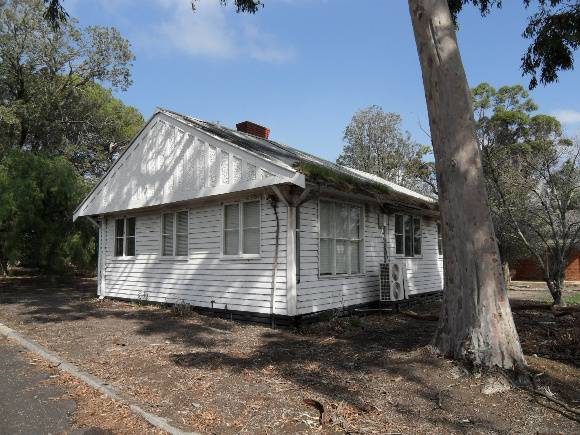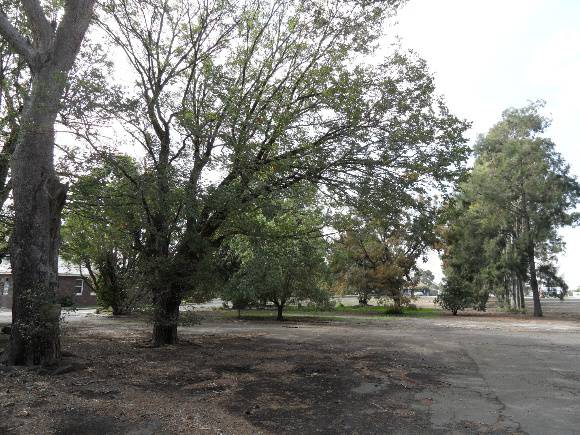| Back to search results » | Back to search page » |
|
Deer Park Explosives Factory Complex
Other NamesI.C.I. Ammonia Plant , Nobel (Australasia) Ltd , Orica Deer Park Explosives Factory Complex Location751 - 775 Ballarat Road & 2 - 50 Station Street, DEER PARK VIC 3023 - Property No B5849
File NumberB5849LevelState |
|
Statement of Significance
What is significant? The Deer Park explosives factories complex comprises buildings, structures and landscape features relating to a number of phases of manufacture. It includes remains of the nineteenth century dynamite factory administration building and later laboratory located in the north east of the site near Kororoit Creek (the 'White House'); the initiator and ammunition sections on Tilburn Road; the Leathercloth Factory complex on Station Road; and remnants of the Federal Fertiliser Factory and Black powder works at the (now discontinued) Fitzgerald Road.
How is it significant? The Deer Park Explosives factories complex is significant for historical, technical, social and aesthetic/architectural reasons at a State level.
Why is it significant? The Deer Park factory complex is of historical significance as the location of the first plant for the manufacture of high explosives in Australia and has been, for its entire history, the most important, if not only, commercial manufacturer of high explosives in Australia. It commenced operation under the importer Jones Scott and Co, and then the Australian Lithofracteur Company (Krebs Patent), a rival to Nobel's dynamite patent. The factory was producing nitro-glycerine based explosives in Australia only a couple of years after Nobel's Ardeer factory began operating in Scotland.
The explosives factories complex is of historical significance for the association with the Australian Lithofracteur Company, Australian Explosives and Chemicals, the Nobel company and later ICIANZ, which grew to become one of the largest explosives, chemical and plastics manufacturers in Australia. It was the pioneer of the industry and retained its dominance through monopolistic practices, taking over most of its competitors in the Australasian region. Substantial parts of the pre-Second World War layout of the site remain which, with a number of significant buildings dating back to the 1920s and '30s, indicate past and present processes of manufacturing, the necessary safety measures required and the integrated nature of the explosives and chemical industry.
The factory complex is of historical significance for the major role it played in Australia's manufacturing and mining industries through the development of progressively more efficient and safer explosives. It also contributed to wartime production in ammunition, initiators and the development of synthetic ammonia production and construction of the Defence Explosives Annexe No 5 (later the Albion Explosives Factory) during World War Two. The factory complex is also of technical significance for the unusual and specialised design of many of the buildings and structures, both in the layout of the works and the individual design of buildings. Blast protection and safety measures such as mounds around the buildings, 'cleanways' and buffer zones between production areas were employed extensively. A characteristic of many production buildings was the elimination of cavities where explosive compounds could lodge. The combination of concrete barriers and light-weight construction was designed to direct explosion debris away from operators or other buildings. The narrow gauge tramway, which ran through the explosives section, is a rare survivor of nineteenth century materials-handling methods.
The factory complex is also important for its association as a sponsor of unusual workers housing schemes. The housing estates, initiated by Leathercloth Pty. Ltd. in the 1920s and ICIANZ in the 1950s, demonstrate both the patriarchal nature of the ICI company specifically and much of the region's industry generally, and the basic social and economic difficulties of running such an enterprise in a then relatively isolated location.
The Leathercloth Factory is of significance for its architectural and technical values. The Leathercloth Factory was influential in the development of synthetic materials for the motor industry including vinyl seat fabrics and hoods, and continued to play an important role in synthetic fabrics until the 1960s. The Leathercloth factory was a pioneering enterprise in Australia. No other comparable buildings relating to the same industry from the inter-war period survives in Victoria. Activities in other buildings within the ICI complex at Deer Park produced some of the raw materials used in Leathercloth production. The Leathercloth Factory buildings are also associated with an innovative workers' housing estate with company residences built for the Leathercloth works manager and foremen in Ballarat Road and Station Road.
The White House, used variously as office, laboratory, and manager's residence, has important links with significant phases and leading personnel in the factory's history. From 1874 until the early 1920s it accommodated a resident manager, an essential requirement of such a dangerous industry. The building took on a new role as 'part of factory offices' in 1926-27, after the construction of a new manager's residence in Ballarat Road, and as a laboratory in later years. It is significant as the oldest building on the site, with evidence of its former uses, such as the brick reinforcing buttresses added during its use as a laboratory.
The former Federal Fertilizer works, of which some components remain, reflects the process of diversification in the chemical industry where the waste product of one process, in this case dilute acid, can be turned into a commercial product, superphosphate fertilizer. The now demolished main building was interesting as an example of the solution found to the problem of providing large areas of dry storage for phosphates. The timber buildings dominated the Fitzgerald Road approach to the site and were part of the earliest surviving group of structures relating to the important explosives and chemical companies connected with the site. Remaining structures such as the concrete ammonia store and ancillary workshops remain to demonstrate the former layout of the fertiliser section.
The former Ammunition factory is probably the most intact early to mid twentieth century works associated with ammunition manufacture in Australia, as most comparable places (Lithgow NSW, Hendon SA, Footscray Victoria) have either been demolished or drastically altered. The Proof /Firing Range (AK2) is a unique building within this complex with additional technical and architectural significance for its demonstration of the role of ballistic testing reflected in the special design and form of the building and its fittings.
The site has aesthetic significance in relation to individual buildings including the Victorian era style of the White House, the Art Deco offices at the Explosives Ammunition factory (of particular note being the roundel logo of Nobel company, and facade signage on the former explosive factory office), and the inter-war Leathercloth factory building. Distinctive building forms include barrel vaulted roofs supported by Belfast Trusses. The grounds have extensive landscaping and remnants of tree planting (including an avenue of date palms) and lawns.
The site retains archaeological remains of many structures.
The site is of social significance. It was situated in an isolated but close-knit community, where many people had a family connection to the company or lived in the ICI 'Garden City' housing estate. Local people called the complex 'The Blowups', a reference to the history of accidental explosions on the site.
Classified: 03/06/2010
Group
Manufacturing and Processing
Category
Factory/ Plant





